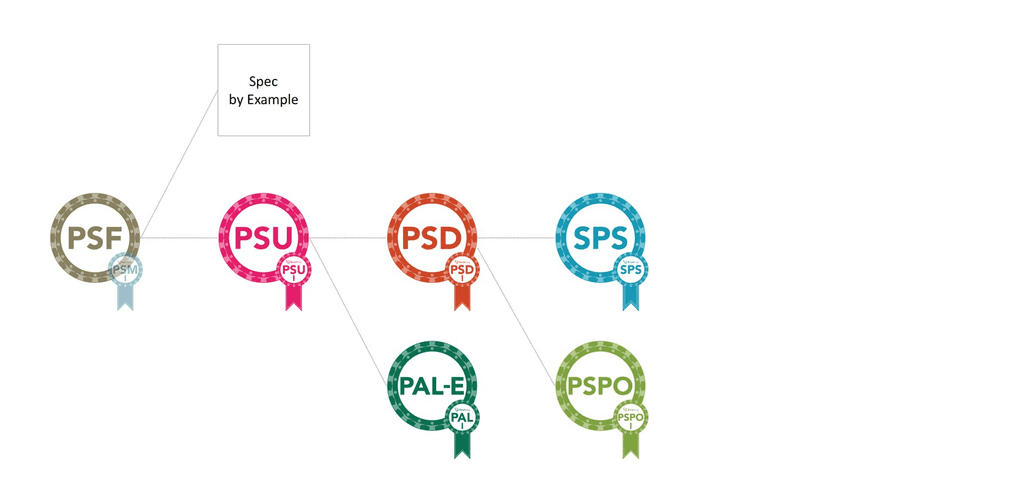Certification Path for UX Leads
Published:
Starting with APS (Applying Professional Scrum), a crash-course in iterative & incremental product development with self-organizing teams, a UX Leader could then explore new blends of design and engineering (PSU, Spec by Example), considerations for multi-team environments (SPS), and team leadership (PAL-E, PSPO).

Brief History of UX
Distant Past
Studies of our distant past (pre-1992!) indicate that nobody thought to listen to their users!**
Yes, I’m exaggerating. But only a little. How else could this be explained?

The more complete truth is, particularly with digital product, the aspirations of human-computer interaction were awfully limited by technology constraints of the day. The realm of interaction design has tracked many failures, but not for the lack of trying.
Early 90’s to Present Day

The fine work of Don Norman, Steve Krug, Alan Cooper (and others) indicate a change of mind. Computer hardware and software had become sufficiently powerful (and relatively inexpensive) as to allow sophisticated user interaction. It became apparent that the most successful products and companies were those which took seriously the feedback from end-users. The phrase “user-centered design” began a wave of changes in all design disciplines.
Fast-forward to present-day: Measurable and universal improvements have been made with respect to user interface design. Users now expect first-class treatment; and often, they get it.
Design experts are increasingly aware that design is a testing activity. Excellent user experience is best achieved with tight feedback loops — and the richest feedback is derived from 'done' product. It’s no longer appropriate (if it ever was) to segregate design from development.
The best minds in the field are generally accepting the fact that the acts of designing, coding, testing, and using are not separate — trying to separate those activities (as if that’s possible) compromises quality and introduces risk and delay.
Most designers I know are well-versed and self-motivated to learn about design thinking, user-centered design, usability testing, and so on. (Practices in which designers can perform in a silo.) Those are not the skills-gaps I observe. Rather, most designers I know have not experienced, nor are they as interested in, team-based design practices like pair-programming, design in-browser, interactive proto-typing (with real UI, not sketched UI). And so on. (Activities in which design and code emerge simultaneously.)
To fill that gap, the path illustrated above provides exposure to a set of ideas and practices not yet typical of design disciplines.
Certifications for UX Leads
Core Scrum.org Courses
Core courses I recommend for UX Leads are illustrated above along the main horizontal path (left to right).
- APS: Applying Professional Scrum
A training course (which is an alternate path to PSM I certification) is a hands-on, product development simulation. People describe it as “a profound experience” and it serves well to help people understand real Scrum.
- PSU: Professional Scrum with User Experience
A training course (with a parallel certification) which covers things like:
- design thinking in light of frequent delivery;
- design systems and how they can map to software engineering design patterns;
proper dual-track development;
- design is a discipline, not a job title;
- how LeanUX and Scrum are both Empirical process control frameworks;
- how great Scrum teams are also great Lean UX designers.
- PSD: Professional Scrum Developer
A training course (with a parallel certification) which covers things like:
- foundational programming concepts;
- Scrum with Agile engineering and DevOps practices;
- incremental design (e.g. architectural, visual).
This brief experience certainly helps bridge an empathy gap (if not also a knowledge gap) between design-minded and code-minded team members.
- SPS: Scaled Professional Scrum
A training course (with a parallel certification) which covers things like:
- Product development with multiple Scrum teams;
- maintaining high levels of transparency and cohesion in a multi-team environment.
Related Scrum.org Courses
Related courses are illustrated below the main horizontal path.
- PAL-E: Professional Agile Leadership Essentials
For UX ‘Lead’ roles, this training course (with an accompanying certification: PAL I) would help to:
- develop practical skills to guide and coach design-skilled team members to participate in self-organizing teams;
- assess the efficacy of design practices (across the development organization) in light of iterative & incremental development.
- PSPO: Professional Scrum Product Owner
A training course (with parallel certification) which would help a UX leader to:
better understand the overlap and difference between the roles of Product Owner and designer;
- assess the efficacy of design practices (across the development organization) with respect to a Product Owner’s accountabilities;
- develop empathy for other roles in a Scrum Team.
Related Courses (Beyond Scrum.org)
Recommended courses through other organizations (not Scrum.org) are illustrated above the main horizontal path.
- Specification by Example
(Self-study or pursue master classes with Gojko Adžić, or his students.) This material would help a UX leader to:
- assess the efficacy of design practices (across the development organization) in light of managing requirements of significant complexity;
explore an alternate sense-making approach (alternate to the common practices of typical design disciplines) to envision abstractions or novel ideas/concepts by way of boundary stories, examples, and tests;
- communicate, with ubiquitous language, between business stakeholders, designers, and engineers.
All About Certification — A Blog Series: Table of Contents
This article is one part in a series I started in 2019 to address questions that I frequently receive about training courses and certifications.